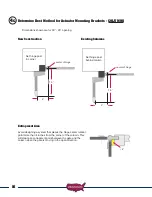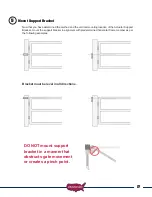
2
Understanding Current UL325 & ASTM F2200-14 Requirements
Effective January 12, 2016 a vehicular gate operator or vehicular barrier (arm) operator shall have
provisions for, or be supplied with, at least two independent entrapment protection means as specified
in current UL325 standard Table 31.1. At installation, both entrapment protection devices must be
installed and operational before gate operation is allowed.
USAutomatic control boards utilize Type A (Inherent entrapment protection system) as the first
entrapment protection means identified. This is designed into the control boards for all USAutomatic
operators. The second entrapment identified must be a monitored Type B1 or Type B2 device that is
UL325 compliant and monitored.
Type B1 - Non-contact sensor (photoelectric sensor or the equivalent). Identified as Normally Closed
N/C contact switching.
Type B2 - Contact sensor (edge device or the equivalent). Identified as 10K resistor installed for
presence monitoring.
The entrapment zones illustration defines the most common entrapment areas. It is the
responsibility of the installer to identify these entrapment areas and install the UL325
compliant monitored entrapment device or devices to protect each area identified.
When installing a USAutomatic control board (part # 500510) in a system manufactured
before Jan. 12, 2016 that is not being upgraded to meet the current UL325 standard the
Pre 2016 jumper must be installed into J5 terminal block for proper operation.
USAutomatic recommends upgrading all systems to current UL325 standards
UL325 identifies four different classes of gate operators.
These classes are:
RESIDENTIAL VEHICULAR GATE OPERATOR – CLASS I
A vehicular gate operator (or system intended for use in garages or parking areas associated with a
residence of one-to four single families.
COMMERCIAL/GENERAL ACCESS VEHICULAR GATE OPERATOR – CLASS II
A vehicular gate operator (or system)intended for use in a commercial location or building such as
a multi-family housing unit (five or more single family units), hotel, garages, retail store, or other
buildings accessible by or servicing the general public.
INDUSTRIAL/LIMITED ACCESS VEHICULAR GATE OPERATOR – CLASS III
A vehicular gate operator (or system) intended for use in an industrial location or building such as a
factory or loading dock area or other locations not accessible by or intended to service the general
public.
RESTRICTED ACCESS VEHICULAR GATE OPERATOR – CLASS IV
A vehicular gate operator (or system) intended for use in a guarded industrial location or building
such as an airport security area or other restricted access locations not servicing the general public,
in which unauthorized access is prevented via supervision by security personnel.
Ranger gate operators are intended for use on Class I, II, III, & IV vehicular gates.





































